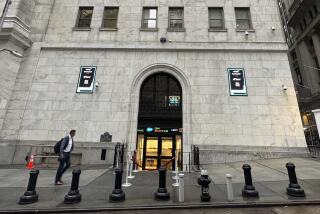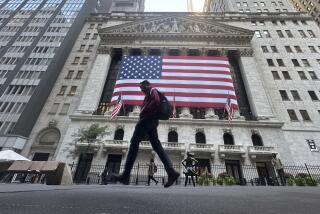Dow Gains 3.6% in July
Wall Street closed out July with some profit taking on Friday, but the selling put only a slight dent in the broad market’s best monthly rally this year.
The Dow Jones industrial average lost 64.64 points, or 0.6%, to 10,640.91. It still was up 3.6% in July, its best monthly rise since November, when it gained 4%.
Some investors stepped back as the government estimated that the economy grew at a 3.4% annualized real rate in the second quarter. The growth rate met expectations and pointed to continued strength in the expansion. But it also raised fresh concerns about how much more credit tightening the Federal Reserve would do.
Treasury bond yields rose on the report, pushing the two-year T-note above 4% for the first time since 2001, to 4.01%, up from 3.95% on Thursday.
The benchmark 10-year T-note ended at 4.28%, up from 4.19% on Thursday.
“Interest rates are probably going higher,” said Andrew Harding of the Allegiant Funds in Cleveland. “There is no soft patch” in the economy.
Markets also were rattled Friday by the latest rise in oil prices, which climbed above $60 a barrel for the first time since July 13. Near-term futures in New York were up 63 cents to $60.57.
Even so, Wall Street for most of this month has shown little concern about interest rates or oil and has focused more on surprisingly strong second-quarter earnings reports -- a byproduct of the economy’s health.
Case in point: Shares of grocery chain Whole Foods Markets rocketed $14.19 to a record $136.51 on Friday after the firm said quarterly earnings were up 31%, exceeding expectations.
With nearly 75% of companies in the blue-chip Standard & Poor’s 500 companies having reported results, operating earnings for the index overall are projected to have risen 11.1% in the quarter from a year earlier, according to research firm Thomson Financial.
That estimate is up from the 8.8% growth Thomson projected at the start of the month.
Of the 370 S&P; companies that have reported results, 69% have beaten analysts’ expectations, 15% have matched them and 15% have fallen short, Thomson said. In a typical quarter, 59% of companies beat expectations, the firm said.
Profit strength has underpinned the equity market, lifting some broad-based indexes to all-time highs in recent days. The New York Stock Exchange composite, for example, closed at a record high Thursday, although it slipped 0.5% on Friday as losers outnumbered winners by about 3 to 2 in the session.
Robust earnings gains at biotechnology companies Amgen and Genentech helped make that sector one of the market’s hottest this month: The Nasdaq biotech index surged 12%.
But the July rally wasn’t limited to a few sectors. The S&P; 500, which eased 9.54 points, or 0.8%, to 1,234.18 on Friday, was up 3.6% for the month.
The technology-dominated Nasdaq composite lost 13.61 points, or 0.6%, to 2,184.83 on Friday but was up 6.2% for the month, lifted in part by a surge in semiconductor stocks amid some upbeat profit reports in that sector. The SOX index of major chip stocks rocketed 13.2% in July.
Transportation stocks also posted strong gains amid optimism about the economy. The Dow transportation stock index was up 9% for the month.
Small and mid-size stocks continued to outshine blue chips as they have for much of the last five years. S&P;’s indexes of those market sectors both hit record highs this week.
Despite the July rally, the S&P; 500 is only slightly positive year to date, up 1.8%. The Dow still is in the red, off 1.3%. And some analysts are wondering how much higher stocks can go in the near term.
“Yes, you have good economic data, but you’re running up against a market that’s recently hit some very good highs,” said Rod Smyth, chief investment strategist at Wachovia Securities. “July was a great month for stocks. But traders are starting to think that we’re done for now, that the upside-to-downside odds, in the short term, are getting less and less good.”
The Fed looms: Policymakers will meet Aug. 9 and they’re expected to raise their benchmark short-term rate from 3.25% to 3.5%. It would be the 10th increase since June 2004.
Wall Street has largely reconciled that the Fed will continue to tighten credit at least until December, many analysts say. The bigger question is whether the rate increases will persist into 2006.
Some money managers say the market rally deserves the benefit of the doubt.
“Inflation will remain relatively well contained, and as a result of that, we think we’ll have a pretty good environment for corporate earnings,” said Hugh Mullin, manager of the $17-billion Putnam Fund for Growth and Income in Boston. “We are pretty constructive about the market.”
*
(BEGIN TEXT OF INFOBOX)
Broad rally
The stock market’s advance was broad-based in July. How key indexes have fared:
*--* Price change: Index July YTD Nasdaq biotech +12.0% +0.6% Dow transports +9.0 +0.1 Nasdaq composite +6.2 +0.4 S&P; small-cap +6.0 +7.3 NYSE energy +5.3 +22.5 S&P; mid-cap +5.2 +8.6 NYSE composite +3.6 +3.1 Dow industrials +3.6 --1.3 S&P; 500 +3.6 +1.8 Dow utilities +2.8 +18.6
*--*
Source: Bloomberg News
More to Read
Inside the business of entertainment
The Wide Shot brings you news, analysis and insights on everything from streaming wars to production — and what it all means for the future.
You may occasionally receive promotional content from the Los Angeles Times.










